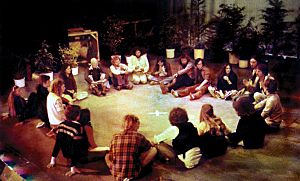Counterculture facts for kids
A counterculture is a group of people whose ideas, beliefs, and ways of living are very different from what is common or expected in society. These groups often have their own unique styles, music, and ways of thinking. Their values and behaviors are often quite different from what most people in society consider normal.
What is a Counterculture?
A counterculture is like a smaller group within a larger society. This smaller group has its own special ways of doing things. These ways are often opposite to the main culture. They might have different ideas about art, music, fashion, or how people should live.
Why Do Countercultures Form?
Countercultures often form when people feel that the main society does not meet their needs. They might want more freedom or new ways to express themselves. Sometimes, they want to challenge old ideas or traditions. They create their own communities and rules.
Famous Countercultures in History
Throughout history, there have been many famous countercultures. These groups have often brought new ideas to the world. They have influenced art, music, and how people think.
The Romantic Movement (1790–1840)
The Romantic movement was one of the first big countercultures. It started in the late 1700s. People in this movement valued feelings, imagination, and nature. They were often artists, writers, and musicians. They felt that logic and reason were not enough. They wanted to explore strong emotions and the beauty of the natural world. This was different from the strict rules of the time.
Romantic Art and Ideas
Romantic artists painted dramatic landscapes and emotional scenes. Writers told stories about heroes and adventures. They believed in the power of the individual. They also loved folk tales and ancient myths. This movement changed how people saw art and life.
Bohemianism (1850–1910)
Bohemianism appeared in the mid-1800s. It was a lifestyle adopted by artists, writers, and musicians. They often lived in poor areas of big cities. They chose a simple life focused on art and creativity. This was a contrast to the wealthy, traditional society.
Bohemian Lifestyle and Influence
Bohemians often wore unusual clothes. They lived freely and did not care much about money. They wanted to live for their art. Their ideas influenced many future artists. They showed that a different way of life was possible.
The Beat Generation (1944–1964)
The Beat Generation started in the 1940s in America. It was a group of writers and poets. They questioned the traditional American way of life after World War II. They felt society was too focused on money and rules. They wanted more freedom and spiritual meaning.
Beatniks and Their Message
Members of the Beat Generation were sometimes called "Beatniks." They liked jazz music and new forms of poetry. They often traveled and explored different ideas. They wrote about their feelings and experiences. They inspired many young people to think differently.
The Counterculture of the 1960s (1964–1974)
The 1960s saw a very famous counterculture. It is often linked with the hippie movement. This group of young people wanted peace and love. They were against war and traditional ways of living. They wanted a more open and fair society.
Hippies and Their Impact
Hippies wore colorful clothes and grew their hair long. They listened to rock music and lived in communities. They promoted peace and environmental care. Their ideas had a big impact on music, fashion, and social change. They showed a strong desire for a different world.
The Punk Subculture (1970s)
The punk subculture emerged in the 1970s. It was a reaction against what they saw as boring society. Punks wanted to shock people and challenge authority. They had a very distinct style and loud music.
Punk Music and Fashion
Punk music was fast and energetic. It often had simple, direct lyrics. Punks wore ripped clothes, safety pins, and bright hair colors. They wanted to show that anyone could make music or art. They encouraged people to be themselves and not follow the crowd.
Images for kids
See also
 In Spanish: Contracultura para niños
In Spanish: Contracultura para niños



